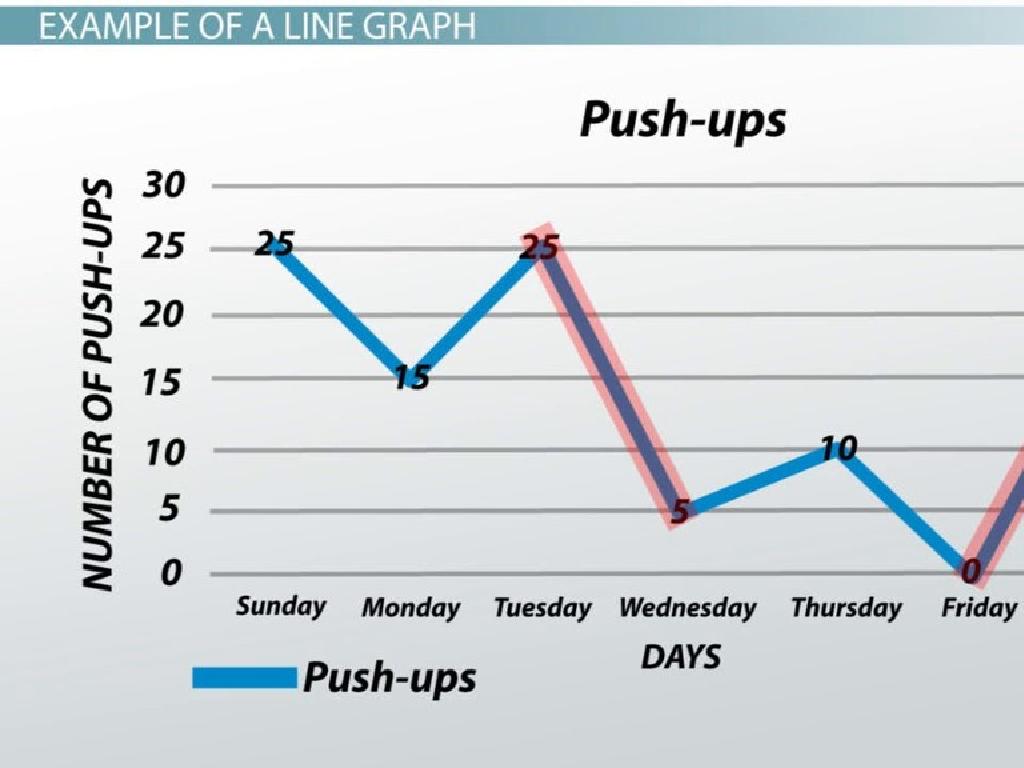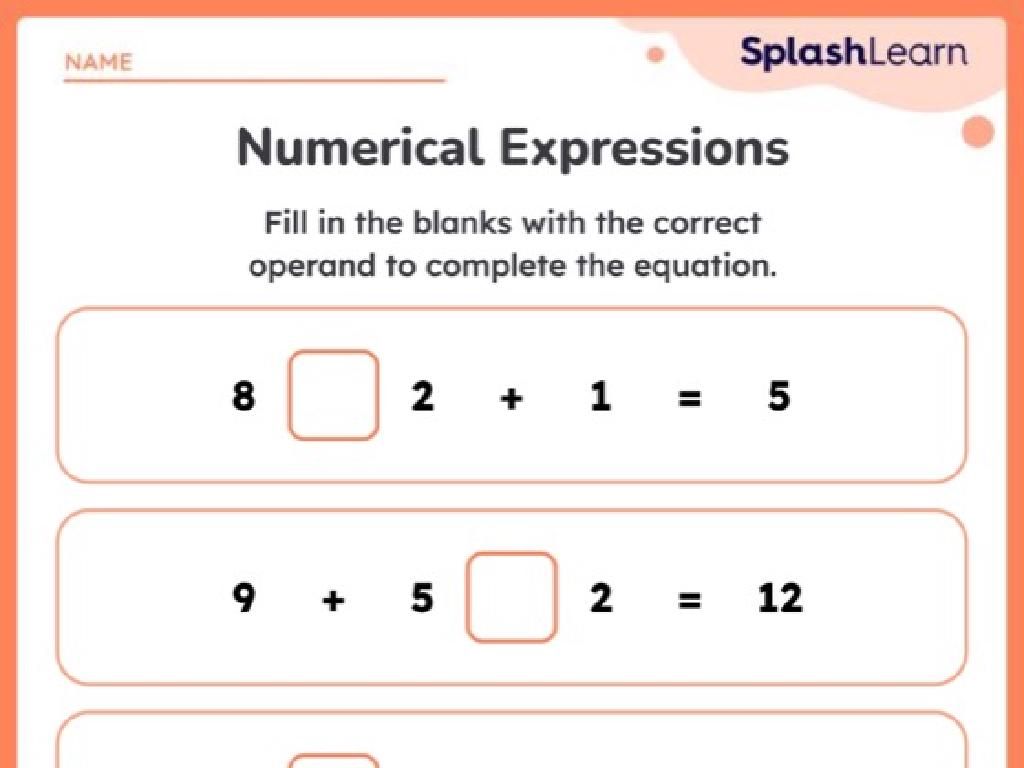Write Equations For Lines Of Best Fit
Subject: Math
Grade: Eighth grade
Topic: Two-Variable Statistics
Please LOG IN to download the presentation. Access is available to registered users only.
View More Content
Introduction to Two-Variable Statistics
– Explore relationships between variables
– How one thing affects another, like height and shoe size
– Define two-variable statistics
– It’s the study of how two different things relate statistically
– Real-world two-variable stats
– Examples: temperature vs. ice cream sales, study time vs. test scores
– Significance in everyday life
|
This slide introduces the concept of two-variable statistics, which is essential for understanding how different variables can influence each other. Start by explaining that a variable is anything that can change or vary, such as height, weight, temperature, etc. Discuss how two-variable statistics help us to understand and quantify the relationship between these variables. Provide relatable examples such as how warmer weather might increase ice cream sales, or how more study time could improve test scores. Emphasize the importance of this statistical tool in various fields like economics, health, and education. Encourage students to think of other examples where two variables might be related in their daily lives.
Understanding the Line of Best Fit
– Define Line of Best Fit
– A straight line that best represents data on a scatter plot
– Purpose of Line of Best Fit
– To predict unknown values and understand the relationship between variables
– Line of Best Fit & Data
– It shows the general direction that a group of points seem to be heading.
– Visualizing Data Trends
|
The Line of Best Fit, also known as the trend line, is an important concept in statistics that represents the relationship between two variables on a scatter plot. It is the straight line that best passes through the center of the data points and is used to predict or estimate data points within the dataset. When explaining this concept, emphasize the purpose of the line of best fit in making predictions and understanding the correlation between variables. Show how the line of best fit can be drawn by eye or calculated using statistical methods to minimize the distances of the points from the line. Provide examples of scatter plots and practice drawing lines of best fit to reinforce the concept. Discuss how this line helps in visualizing the data trend and making inferences about the data.
Plotting Data for Line of Best Fit
– Collect data for two variables
– Gather numerical data for variables of interest
– Set up coordinate axes
– Label horizontal (x-axis) and vertical (y-axis) appropriately
– Plot data points on scatter plot
– Each pair of numbers becomes a point on the graph
– Understand the scatter plot
– Look for a pattern or trend in the plotted data
|
This slide introduces students to the initial steps of creating a line of best fit by starting with the basics of plotting data on a scatter plot. Students should collect data for two related variables, such as height and shoe size. They will then learn to set up a graph with clearly labeled axes, including units of measurement. After plotting the data points, students should observe the overall pattern to determine if there is a positive, negative, or no correlation. This visual representation is crucial for understanding how to later draw a line of best fit. Encourage students to practice with different data sets to become comfortable with plotting points and interpreting scatter plots.
Drawing a Line of Best Fit
– Estimate best fit line visually
– Observe the overall direction of data points and draw a line that seems to best represent them.
– Balance points above & below
– Adjust the line so that it has roughly equal numbers of points above and below, minimizing the overall distance.
– Line should reflect data trend
– Make sure the line follows the pattern of the data, showing the general direction the points are heading.
– Practice with scatter plots
|
This slide introduces the concept of drawing a line of best fit, which is crucial in understanding two-variable statistics. Students should learn to visually estimate the line that best represents the data on a scatter plot. Emphasize the importance of balancing the distances of points above and below the line to minimize error. The line should capture the main trend of the data, showing whether there is a positive, negative, or no correlation. Provide students with practice scatter plots to apply these concepts and draw their own lines of best fit. Encourage them to check their lines by assessing the balance and trend reflection. This exercise will help them understand the foundational principles of linear regression.
Equations for Lines of Best Fit
– Comprehend slope (m) and y-intercept (b)
– Slope (m) measures steepness, y-intercept (b) is where line crosses y-axis
– Calculate slope using two points
– Use (x1, y1) and (x2, y2) to find m = (y2 – y1) / (x2 – x1)
– Formulate equation from slope and point
– Use y = mx + b to create the line’s equation with your calculated m and a known point
– Interpret line of best fit in data
|
This slide introduces the concept of creating equations for lines of best fit, a key component in understanding two-variable statistics. Start by explaining the slope, which indicates the steepness of the line, and the y-intercept, the point where the line crosses the y-axis. Demonstrate how to calculate the slope using two points from the data set. Then, show how to use the slope and a specific point to formulate the equation of the line. Emphasize the importance of the line of best fit in making predictions based on data. Provide examples and encourage students to practice with real data sets to solidify their understanding.
Calculating the Line of Best Fit
– Steps to calculate manually
– Plot points, draw line, use formula y=mx+b
– Utilizing technology for calculation
– Software like graphing calculators or spreadsheets can aid in finding the line
– Interpreting the line’s equation
– Understand slope (m) and y-intercept (b) in y=mx+b
– Significance of the best fit line
|
This slide aims to guide students through the process of calculating and interpreting the line of best fit in two-variable statistics. Start by explaining the manual calculation, which involves plotting data points on a graph, drawing a line that best represents the data, and then using the formula y=mx+b to define the line mathematically. Emphasize the use of technology such as graphing calculators or spreadsheet software to simplify this process. Teach students how to interpret the slope and y-intercept of the equation, which represents the rate of change and the starting point, respectively. Highlight the importance of the line of best fit in making predictions based on data. Encourage students to practice both manual and technological methods to reinforce their understanding.
Line of Best Fit: Examples and Practice
– Example: Line of Best Fit
– Given data set, plot points and draw a line that best represents the data.
– Practice: Calculate the Line
– Use a data set to determine the line of best fit on your own.
– Review solutions and errors
– Discuss solutions and analyze frequent errors made in calculations.
– Understand common issues
– Learn to avoid typical mistakes in plotting and equation forming.
|
Begin with a clear example, showing students how to plot a data set and draw the line of best fit. Move on to a practice problem where students calculate the line of best fit for a new set of data. Afterward, review the solutions as a class, highlighting common mistakes such as misplotting points or incorrect slope calculation. Emphasize the importance of checking work for accuracy. This exercise will help students understand the process of creating a line of best fit and how it can be used to make predictions based on data.
Class Activity: Crafting Lines of Best Fit
– Collect class data in groups
– Plot data and draw the line of best fit
– Use graph paper or software for accuracy
– Derive the equation of your line
– Use the formula y = mx + b to find your line’s equation
– Present findings and equations to class
|
This interactive group activity is designed to help students understand the concept of a line of best fit in a two-variable statistical context. Each group will collect data, perhaps on a topic relevant to their interests or daily life, to ensure engagement. Once data is collected, students will plot the points on a graph and visually determine the line that best represents the data trend. They will then use their understanding of the slope-intercept form (y = mx + b) to write the equation for their line. Afterward, each group will present their plotted data, the drawn line of best fit, and the corresponding equation, explaining how they determined the slope and y-intercept. The teacher should circulate to provide guidance and ensure that each group understands the process. Possible activities could include measuring and recording heights vs. arm span, daily temperature vs. hours of sunlight, or homework time vs. test scores.
Conclusion: Lines of Best Fit & Homework
– Recap: Lines of Best Fit
– Summarize how to draw and calculate the equation of a line of best fit.
– Importance in various fields
– Discuss how this concept applies in science, economics, and more.
– Homework: Real-World Data Set
– Find data, like heights vs. shoe sizes, and plot the points.
– Determine your Line of Best Fit
– Use the methods learned to calculate the line that best represents the data.
|
As we conclude, remind students of the steps to create a line of best fit and its equation. Emphasize the real-world applications of two-variable statistics in fields such as science, economics, and social sciences, where it’s used to predict trends and make decisions. For homework, students should find a real-world data set, plot the data points on a graph, and apply what they’ve learned to determine the line of best fit. This exercise will reinforce their understanding and show the practical use of statistics. Encourage creativity in choosing data sets and remind them to be ready to explain their process and reasoning in the next class.





